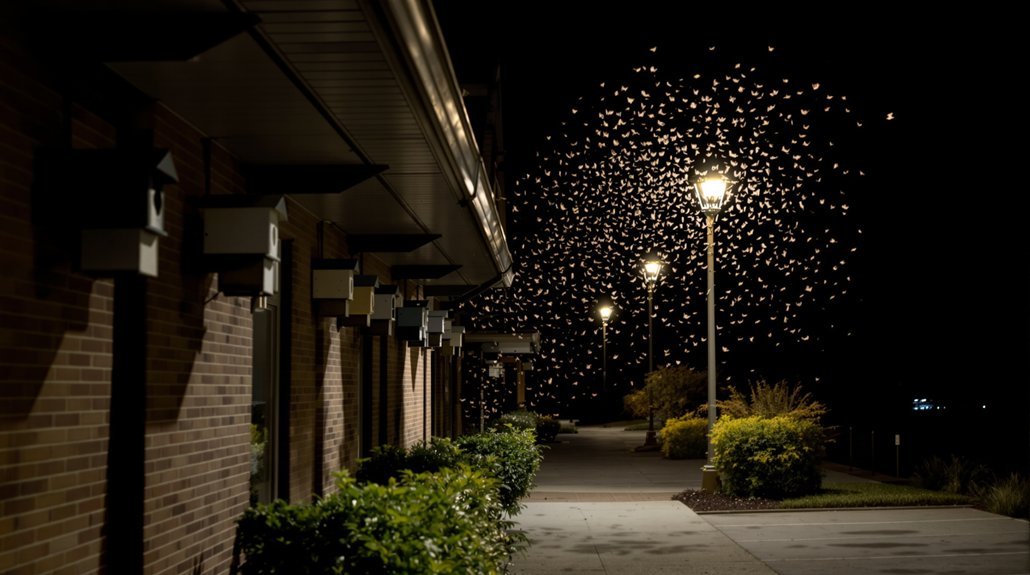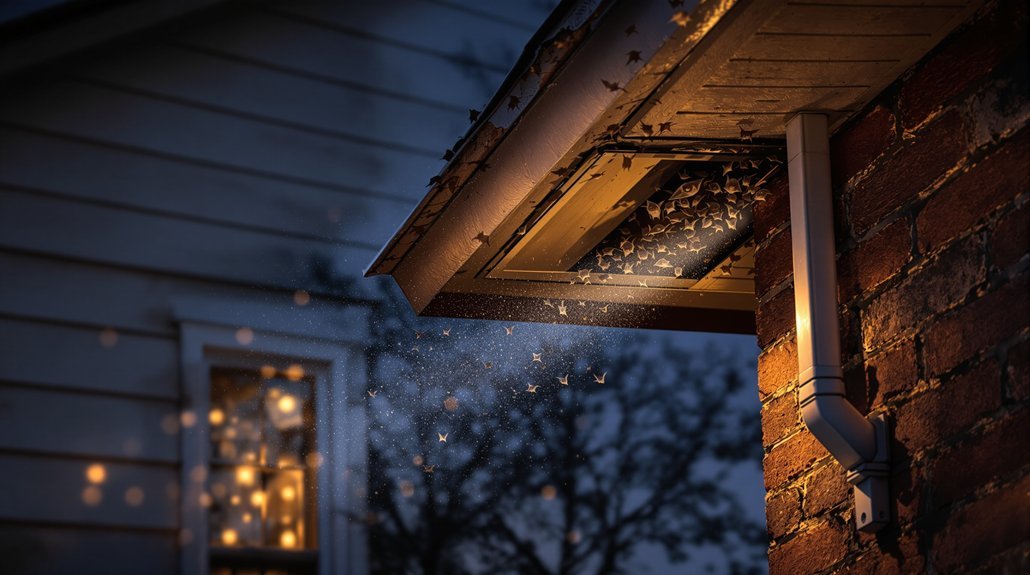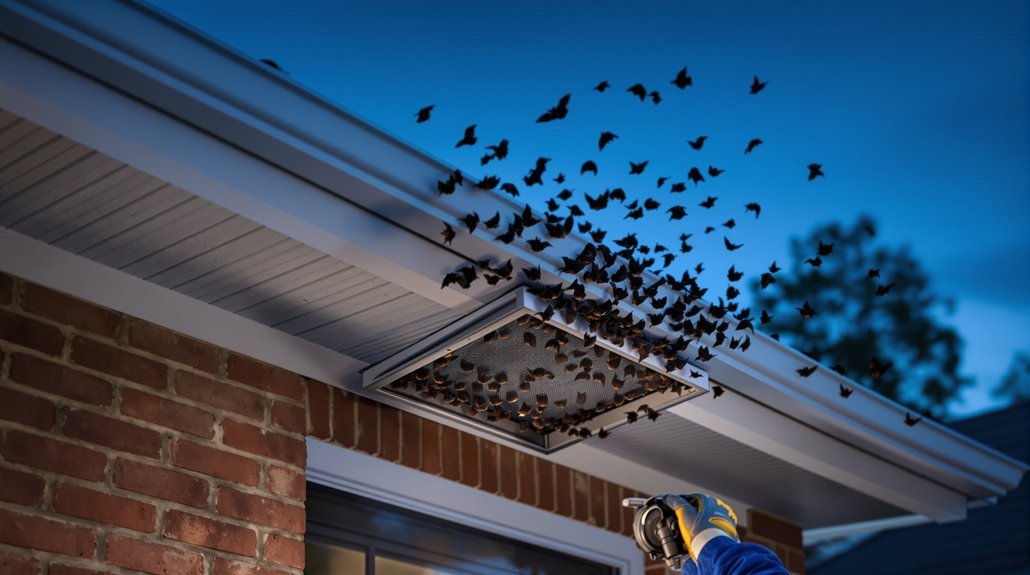To encourage bats to leave in Des Moines, identify their entry points such as gaps in roofing and vents. Use one-way exclusion devices that allow bats to exit but prevent re-entry. Seal all openings after removal to avoid future infestations. Creating an unfavorable environment can also help, like controlling insects and maintaining cleanliness. Monitoring bat activity is essential during the breeding season. More effective strategies can be discovered with further insights into bat behavior and prevention methods.
Key Article Highlights
- Install one-way exclusion devices to allow bats to exit while preventing their return to your Des Moines property.
- Seal all potential entry points, including gaps in roofing, vents, and cracks in windows and doors.
- Monitor bat activity to ensure exclusion efforts are effective and that all bats have left the premises.
- Remove bat guano safely to reduce health risks and discourage bats from returning to the area.
- Consult with professional bat removal experts to ensure safe and humane handling while minimizing structural damage.
Understanding Bat Behavior and Habitat

Although bats are often misunderstood, understanding their behavior and habitat is essential for effective management. Bats play a crucial role in ecosystems, primarily through their feeding habits. They consume insects, which helps control pest populations, benefiting agriculture and human health. Different bat species exhibit varied roost preferences, often choosing warm, dark spaces for shelter, such as attics, caves, or tree hollows. These preferences can influence where they establish colonies and find food. Recognizing these patterns can aid in creating suitable environments for bats, while also encouraging them to relocate from human spaces. By understanding their behaviors and habitats, communities can implement effective strategies to manage bat populations while promoting their important ecological contributions. Additionally, timing exclusion efforts correctly—preferably in late summer—ensures young bats are able to leave their roosts safely bat behavior and timing, leading to more successful mitigation. Proper inspections and habitat modifications can further guide bats toward more appropriate roosting sites habitat preferences, reducing the likelihood of human-bat conflicts.
Identifying Entry Points in Your Home

Bats often seek shelter in homes, making it important for homeowners to identify how they enter. Understanding entry points can help prevent these creatures from roosting indoors, as they prefer dark, secluded areas. Homeowners should inspect their property carefully for potential openings.
Bats often invade homes, so identifying entry points is crucial to keep them from roosting indoors.
Here are key areas to examine:
- Gaps in roofing: Look for loose shingles or holes that may allow entry.
- Vents and chimneys: Ensure these are properly sealed to prevent access.
- Window frames and doors: Check for cracks or poor seals.
- Siding and eaves: Inspect for spaces that could accommodate bats seeking shelter.
Safe and Humane Exclusion Techniques

When homeowners decide to remove bats from their property, it is crucial to use safe and humane exclusion techniques. These methods help ensure that bats leave without harm, allowing them to return to their natural habitat. Essential steps include sealing entry points and using one-way exclusion devices. Homeowners should also remove bat guano safely, as it can pose health risks.
| Technique | Description | Benefits |
|---|---|---|
| One-Way Exclusion | Devices that allow bats to exit only | Safe removal |
| Sealing Entry Points | Closing gaps and cracks | Prevents re-entry |
| Monitoring Roosts | Observing bat activity | Ensures effectiveness |
| Cleaning Bat Guano | Proper disposal and cleanup | Reduces health risks |
| Installing Roost Fixtures | Providing alternate habitats | Encourages relocation |
Preventing Future Infestations
To effectively prevent future infestations, homeowners must take proactive measures after successfully removing bats from their property. Understanding bat migration and breeding habits is essential for creating a long-term solution. Implementing the following steps can markedly reduce the risk of bats returning:
Homeowners should take proactive steps after bat removal to prevent future infestations and ensure lasting solutions.
- Seal all entry points, including gaps in roofs, walls, and vents.
- Install bat-proof screens on chimneys and other potential access areas.
- Maintain a clean environment by removing food sources, such as insects and standing water.
- Monitor the property regularly, especially during the bat breeding season, to catch potential issues early.
Seeking Professional Help When Necessary
How can homeowners be sure they are handling a bat situation correctly? When faced with a bat problem, professional help may be necessary. Experts understand bat communication and can identify the specific species involved. This knowledge is vital because different species have varying migration patterns and behaviors. Professionals also possess the tools and experience to safely remove bats, ensuring no harm comes to the animals or the structure. Attempting DIY methods can lead to stress for both bats and homeowners. Additionally, experts can help seal entry points to prevent future infestations. Homeowners should not hesitate to seek assistance to guarantee a safe and effective resolution to their bat issues while maintaining respect for these important creatures.

